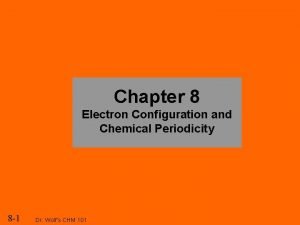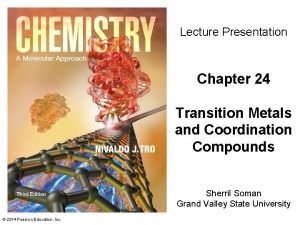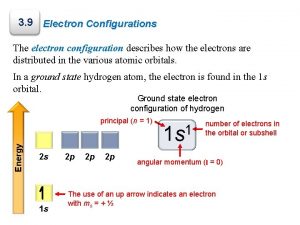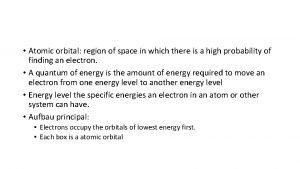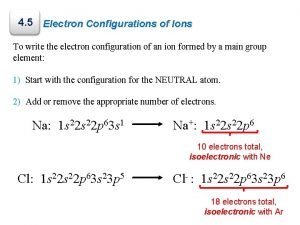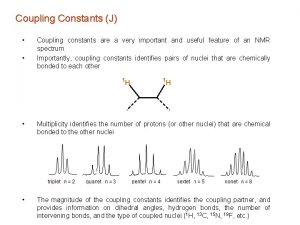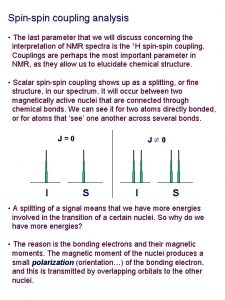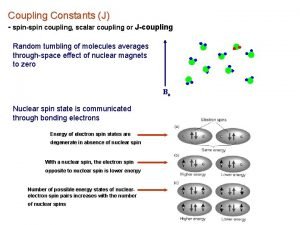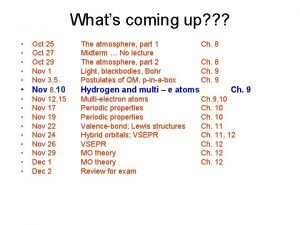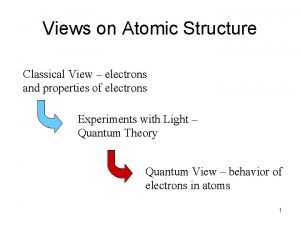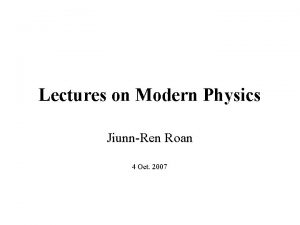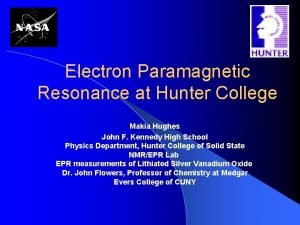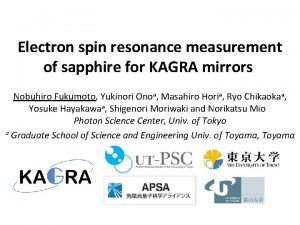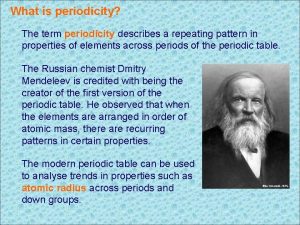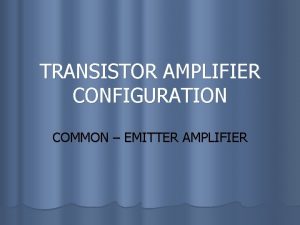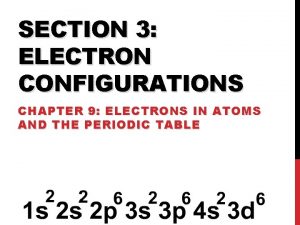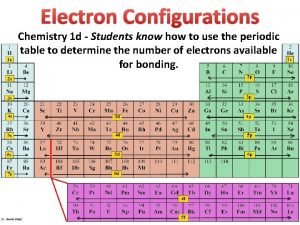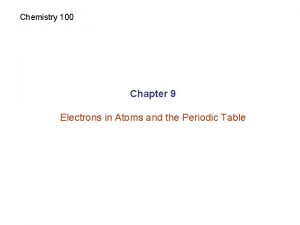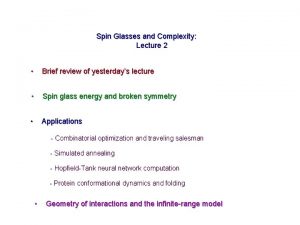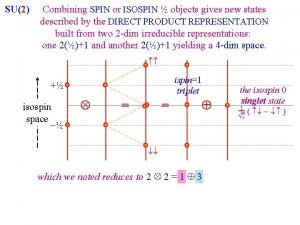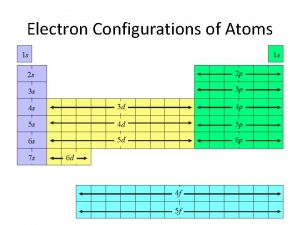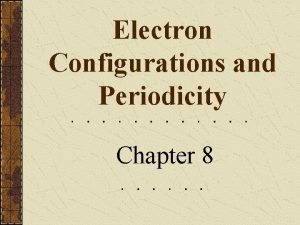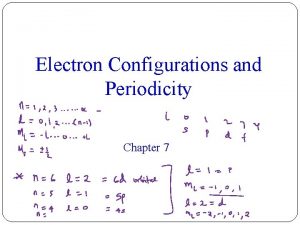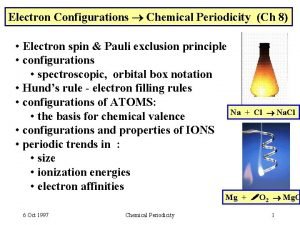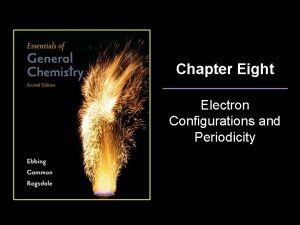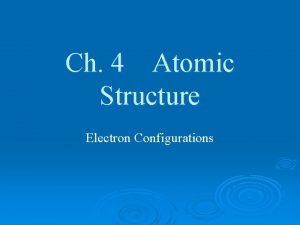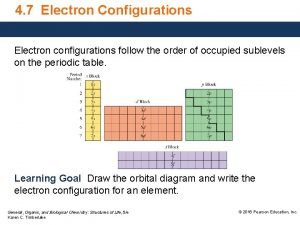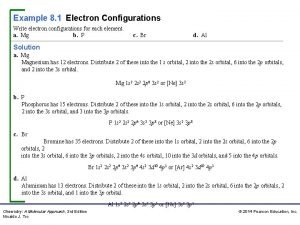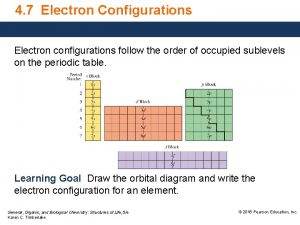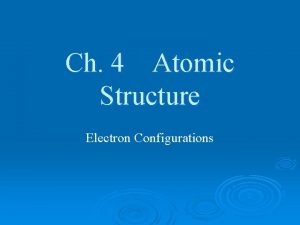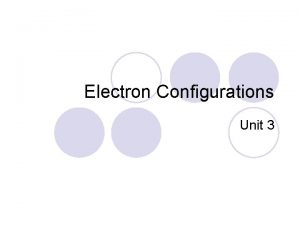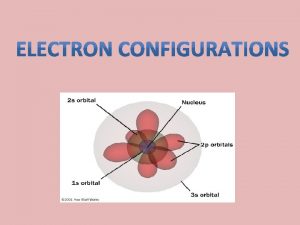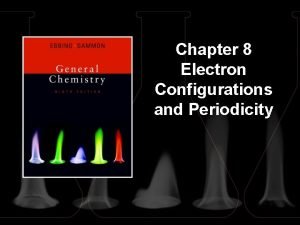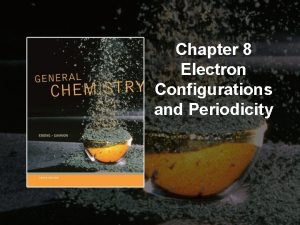Electron Configurations and Periodicity 8 1 Electron Spin













![Aufbau Principle • Here a few examples. – Using the abbreviation [He] for 1 Aufbau Principle • Here a few examples. – Using the abbreviation [He] for 1](https://slidetodoc.com/presentation_image_h2/22a159a6ca7ec6afbdfcd6213b2a5345/image-14.jpg)





































- Slides: 51

Electron Configurations and Periodicity 8. 1 Electron Spin and the Pauli Exclusion Principle 8. 2 Building-up Principle and the Periodic Table 8. 3 Writing Electron Configurations using the Periodic Table

Electron Spin • In Chapter 7, we saw that electron pairs residing in the same orbital are required to have opposing spins. – This causes electrons to behave like tiny bar magnets. A beam of hydrogen atoms is split in two by a magnetic field due to these magnetic properties of the electrons. Figure 8. 2: The Stern-Gerlach experiment. Copyright © Houghton Mifflin Company. All rights reserved. Presentation of Lecture Outlines, 8– 2

Electron Configuration • An “electron configuration” of an atom is a particular distribution of electrons among available sub shells. – The notation for a configuration lists the sub-shell symbols sequentially with a superscript indicating the number of electrons occupying that sub shell. – For example, lithium (atomic number 3) has two electrons in the “ 1 s” sub shell and one electron in the “ 2 s” sub shell 1 s 2 2 s 1. Copyright © Houghton Mifflin Company. All rights reserved. Presentation of Lecture Outlines, 8– 3

Electron Configuration • An orbital diagram is used to show the orbitals of a sub shell are occupied by electrons. – Each orbital is represented by a circle. – Each group of orbitals is labeled by its sub shell notation. 1 s 2 s 2 p – Electrons are represented by arrows: up for ms = +1/2 and down for ms = -1/2 Copyright © Houghton Mifflin Company. All rights reserved. Presentation of Lecture Outlines, 8– 4

The Pauli Exclusion Principle • The Pauli exclusion principle, which summarizes experimental observations, states that no two electrons can have the same four quantum numbers. – In other words, an orbital can hold at most two electrons, and then only if the electrons have opposite spins. Copyright © Houghton Mifflin Company. All rights reserved. Presentation of Lecture Outlines, 8– 5

The Pauli Exclusion Principle • The maximum number of electrons and their orbital diagrams are: Sub shell Number of Orbitals Maximum Number of Electrons s (l = 0) 1 2 p (l = 1) 3 6 d (l =2) 5 10 f (l =3) 7 14 Copyright © Houghton Mifflin Company. All rights reserved. Presentation of Lecture Outlines, 8– 6

Aufbau Principle • Every atom has an infinite number of possible electron configurations. – The configuration associated with the lowest energy level of the atom is called the “ground state. ” – Other configurations correspond to “excited states. ” – Table 8. 1 lists the ground state configurations of atoms up to krypton. (A complete table appears in Appendix D. ) Copyright © Houghton Mifflin Company. All rights reserved. Presentation of Lecture Outlines, 8– 7

Copyright © Houghton Mifflin Company. All rights reserved. Presentation of Lecture Outlines, 8– 8

Aufbau Principle • The Aufbau principle is a scheme used to reproduce the ground state electron configurations of atoms by following the “building up” order. – Listed below is the order in which all the possible sub-shells fill with electrons. 1 s, 2 p, 3 s, 3 p, 4 s, 3 d, 4 p, 5 s, 4 d, 5 p, 6 s, 4 f, 5 d, 6 p, 7 s, 5 f – You need not memorize this order. As you will see, it can be easily obtained. Copyright © Houghton Mifflin Company. All rights reserved. Presentation of Lecture Outlines, 8– 9

Order for Filling Atomic Subshells 1 s 2 s 3 s 4 s 5 s 6 s 2 p 3 p 4 p 5 p 6 p 3 d 4 d 4 f 5 d 5 f 6 d 6 f 1 s, 2 p, 3 s, 3 p, 4 s, 3 d, 4 p, 5 s, 4 d, 5 p, 6 s, 4 f, 5 d, 6 p, 7 s, 5 f Copyright © Houghton Mifflin Company. All rights reserved. Presentation of Lecture Outlines, 8– 10

Orbital Energy Levels in Multielectron Systems (See Animation: Orbital Energies) 3 d Energy 4 s 3 p 3 s 2 p 2 s 1 s 1 s, 2 p, 3 s, 3 p, 4 s, 3 d, 4 p, 5 s, 4 d, 5 p Copyright © Houghton Mifflin Company. All rights reserved. Presentation of Lecture Outlines, 8– 11

Configurations and the Periodic Table • The following slide illustrates how the periodic table provides a sound way to remember the Aufbau sequence. – In many cases you need only the configuration of the outer electrons. – You can determine this from their position on the periodic table. – The total number of valence electrons for an atom equals its group number. Copyright © Houghton Mifflin Company. All rights reserved. Presentation of Lecture Outlines, 8– 12

Configurations and the Periodic Table Copyright © Houghton Mifflin Company. All rights reserved. Presentation of Lecture Outlines, 8– 13
![Aufbau Principle Here a few examples Using the abbreviation He for 1 Aufbau Principle • Here a few examples. – Using the abbreviation [He] for 1](https://slidetodoc.com/presentation_image_h2/22a159a6ca7ec6afbdfcd6213b2a5345/image-14.jpg)
Aufbau Principle • Here a few examples. – Using the abbreviation [He] for 1 s 2, the configurations are Z=4 Beryllium 1 s 22 s 2 or [He]2 s 2 Z=3 Lithium 1 s 22 s 1 or [He]2 s 1 Copyright © Houghton Mifflin Company. All rights reserved. Presentation of Lecture Outlines, 8– 14

Aufbau Principle • With boron (Z=5), the electrons begin filling the 2 p subshell. Z=5 Boron 1 s 22 p 1 or [He]2 s 22 p 1 Z=6 Carbon 1 s 22 p 2 or [He]2 s 22 p 2 Z=7 Nitrogen 1 s 22 p 3 or [He]2 s 22 p 3 Z=8 Oxygen 1 s 22 p 4 or [He]2 s 22 p 4 Z=9 Fluorine 1 s 22 p 5 or [He]2 s 22 p 5 Z=10 Neon 1 s 22 p 6 or [He]2 s 62 p 6 Copyright © Houghton Mifflin Company. All rights reserved. Presentation of Lecture Outlines, 8– 15

Aufbau Principle • With sodium (Z = 11), the 3 s sub shell begins to fill. Z=11 Z=12 Sodium Magnesium 1 s 22 p 63 s 1 1 s 22 p 23 s 2 or [Ne]3 s 1 or [Ne]3 s 2 – Then the 3 p sub shell begins to fill. Z=13 Aluminum • • Z=18 Argon 1 s 22 p 63 s 23 p 1 or [Ne]3 s 23 p 1 1 s 22 p 63 s 23 p 6 or [Ne]3 s 23 p 6 or [Ar] Copyright © Houghton Mifflin Company. All rights reserved. Presentation of Lecture Outlines, 8– 16

Let’s Practice Silicon 1 s 22 p 63 s 23 p 2 Sulfur 1 s 22 p 63 s 23 p 4 or [Ne] 3 s 23 p 4 Arsenic Iron Gadmium Copyright © Houghton Mifflin Company. All rights reserved. 1 s 22 p 63 s 23 p 64 s 23 d 104 p 3 1 s 22 p 63 s 23 p 64 s 23 d 6 or [Ar] 4 s 23 d 6 1 s 22 p 63 s 23 p 64 s 23 d 104 p 6 5 s 24 d 105 p 66 s 25 d 14 f 7 or [Xe] 6 s 25 d 14 f 7 Presentation of Lecture Outlines, 8– 17

Copyright © Houghton Mifflin Company. All rights reserved. Presentation of Lecture Outlines, 8– 18

Configurations and the Periodic Table • Note that elements within a given family have similar configurations. – For instance, look at the noble gases. Helium Neon Argon Krypton 1 s 22 s 22 p 63 s 23 p 63 d 104 s 24 p 6 Copyright © Houghton Mifflin Company. All rights reserved. Presentation of Lecture Outlines, 8– 19

Configurations and the Periodic Table • Note that elements within a given family have similar configurations. – The Group IIA elements are sometimes called the alkaline earth metals. Beryllium 1 s 22 s 2 Magnesium Calcium 1 s 22 s 22 p 63 s 23 p 64 s 2 Copyright © Houghton Mifflin Company. All rights reserved. Presentation of Lecture Outlines, 8– 20

Configurations and the Periodic Table • Electrons that reside in the outermost shell of an atom - or in other words, those electrons outside the “noble gas core”- are called valence electrons. – These electrons are primarily involved in chemical reactions. – Elements within a given group have the same “valence shell configuration. ” – This accounts for the similarity of the chemical properties among groups of elements. Copyright © Houghton Mifflin Company. All rights reserved. Presentation of Lecture Outlines, 8– 21

Let’s try using the Periodic Table to determine the electron configurations. 1 s 22 p 63 s 23 p 4 or [Ne] 3 s 23 p 4 Copyright © Houghton Mifflin Company. All rights reserved.

1 s 22 p 63 s 23 p 64 s 23 d 6 or [Ar] 4 s 23 d 6 Copyright © Houghton Mifflin Company. All rights reserved.

1 s 22 p 63 s 23 p 64 s 23 d 104 p 65 s 24 d 105 p 66 s 25 d 14 f 7 or [Xe] 6 s 25 d 14 f 7 Copyright © Houghton Mifflin Company. All rights reserved.

Electron Configurations and Periodicity 8. 4 Orbital Diagrams of Atoms; Hund’s Rule 8. 5 Mendeleev’s Predictions from the Periodic Table 8. 6 Some Periodic Properties 8. 7 Periodicity in the Main-Group Elements

Orbital Diagrams • Consider carbon (Z = 6) with the ground state configuration 1 s 22 p 2. – Three possible arrangements are given in the following orbital diagrams. 1 s 2 s 2 p Diagram 1: Diagram 2: Diagram 3: – Each state has a different energy and different magnetic characteristics. Copyright © Houghton Mifflin Company. All rights reserved. Presentation of Lecture Outlines, 8– 26

Orbital Diagrams • Hund’s rule states that the lowest energy arrangement (the “ground state”) of electrons in a sub -shell is obtained by putting electrons into separate orbitals of the sub shell with the same spin before pairing electrons. – Looking at carbon again, we see that the ground state configuration corresponds to diagram 1 when following Hund’s rule. 1 s Copyright © Houghton Mifflin Company. All rights reserved. 2 s 2 p Presentation of Lecture Outlines, 8– 27

Orbital Diagrams • To apply Hund’s rule to oxygen, whose ground state configuration is 1 s 22 p 4, we place the first seven electrons as follows. 1 s 2 s 2 p – The last electron is paired with one of the 2 p electrons to give a doubly occupied orbital. 1 s 2 s 2 p – Table 8. 2 lists more orbital diagrams. Copyright © Houghton Mifflin Company. All rights reserved. Presentation of Lecture Outlines, 8– 28

Which are paramagnetic or diamagnetic? Copyright © Houghton Mifflin Company. All rights reserved. Presentation of Lecture Outlines, 8– 29

Magnetic Properties • Although an electron behaves like a tiny magnet, two electrons that are opposite in spin cancel each other. Only atoms with unpaired electrons exhibit magnetic susceptibility. – A paramagnetic substance is one that is weakly attracted by a magnetic field, usually the result of unpaired electrons. – A diamagnetic substance is not attracted by a magnetic field generally because it has only paired electrons. Copyright © Houghton Mifflin Company. All rights reserved. Presentation of Lecture Outlines, 8– 30

Periodic Properties • The periodic law states that when the elements are arranged by atomic number, their physical and chemical properties vary periodically. • We will look at three periodic properties: – Atomic radius – Ionization energy – Electron affinity Copyright © Houghton Mifflin Company. All rights reserved. Presentation of Lecture Outlines, 8– 31

Periodic Properties • Atomic radius – Within each period (horizontal row), the atomic radius tends to decrease with increasing atomic number (nuclear charge). – Within each group (vertical column), the atomic radius tends to increase with the period number. Copyright © Houghton Mifflin Company. All rights reserved. Presentation of Lecture Outlines, 8– 32

Periodic Properties • Two factors determine the size of an atom. – One factor is the principal quantum number, n. The larger is “n”, the larger the size of the orbital. – The other factor is the effective nuclear charge, which is the positive charge an electron experiences from the nucleus minus any “shielding effects” from intervening electrons. Copyright © Houghton Mifflin Company. All rights reserved. Presentation of Lecture Outlines, 8– 33

Figure 8. 17: Representation of atomic radii (covalent radii) of the main-group elements. Copyright © Houghton Mifflin Company. All rights reserved. Presentation of Lecture Outlines, 8– 34

Periodic Properties • Ionization energy – The first ionization energy of an atom is the minimal energy needed to remove the highest energy (outermost) electron from the neutral atom. – For a lithium atom, the first ionization energy is illustrated by: Ionization energy = 520 k. J/mol Copyright © Houghton Mifflin Company. All rights reserved. Presentation of Lecture Outlines, 8– 35

Periodic Properties • Ionization energy – There is a general trend that ionization energies increase with atomic number within a given period. – This follows the trend in size, as it is more difficult to remove an electron that is closer to the nucleus. – For the same reason, we find that ionization energies, again following the trend in size, decrease as we descend a column of elements. Copyright © Houghton Mifflin Company. All rights reserved. Presentation of Lecture Outlines, 8– 36

Figure 8. 18: Ionization energy versus atomic number. Copyright © Houghton Mifflin Company. All rights reserved. Presentation of Lecture Outlines, 8– 37

Periodic Properties • Ionization energy – The electrons of an atom can be removed successively. • The energies required at each step are known as the first ionization energy, the second ionization energy, and so forth. • Table 8. 3 lists the successive ionization energies of the first ten elements. Copyright © Houghton Mifflin Company. All rights reserved. Presentation of Lecture Outlines, 8– 38

Copyright © Houghton Mifflin Company. All rights reserved. Presentation of Lecture Outlines, 8– 39

Periodic Properties • Electron Affinity – The electron affinity is the energy change for the process of adding an electron to a neutral atom in the gaseous state to form a negative ion. • For a chlorine atom, the first electron affinity is illustrated by: Electron Affinity = -349 k. J/mol Copyright © Houghton Mifflin Company. All rights reserved. Presentation of Lecture Outlines, 8– 40

Periodic Properties • Electron Affinity – The more negative the electron affinity, the more stable the negative ion that is formed. – Broadly speaking, the general trend goes from lower left to upper right as electron affinities become more negative. – Table 8. 4 gives the electron affinities of the maingroup elements. Copyright © Houghton Mifflin Company. All rights reserved. Presentation of Lecture Outlines, 8– 41

Copyright © Houghton Mifflin Company. All rights reserved. Presentation of Lecture Outlines, 8– 42

Group IA, Alkali Metals • • • Largest atomic radii React violently with water to form H 2 Readily ionized to 1+ Metallic character, oxidized in air R 2 O in most cases Sodium reacting with water. Copyright © Houghton Mifflin Company. All rights reserved. Presentation of Lecture Outlines, 8– 43

Group IIA, Alkali Earth Metals • • Readily ionized to 2+ React with water to form H 2 Closed s shell configuration Metallic Copyright © Houghton Mifflin Company. All rights reserved. Presentation of Lecture Outlines, 8– 44

Transition Metals • • May have several oxidation states Metallic Reactive with acids Produce color in compounds Cu. SO 4 • 5 H 2 O Cu. SO 4 Copyright © Houghton Mifflin Company. All rights reserved. Cr compounds Fe Hg and oxide Presentation of Lecture Outlines, 8– 45

Group III A • Metals (except for boron) • Several oxidation states (commonly 3+) Gallium-melts in your hand. Copyright © Houghton Mifflin Company. All rights reserved. Presentation of Lecture Outlines, 8– 46

Group IV A • Form the most covalent compounds • Oxidation numbers vary between 4+ and 4 - Oxides from this group Copyright © Houghton Mifflin Company. All rights reserved. Presentation of Lecture Outlines, 8– 47

Group V A • Form anions generally(1 -, 2 -, 3 -), though positive oxidation states are possible • Form metals, metalloids, and nonmetals I have no picture of Group V elements so this is one of my grandsons, Kaden. He’s in a group of his own. Copyright © Houghton Mifflin Company. All rights reserved. Presentation of Lecture Outlines, 8– 48

Group VI A • Form -2 anions generally, though positive oxidation states are possible • React vigorously with alkali and alkali earth metals • Nonmetals Burning of Sulfur Copyright © Houghton Mifflin Company. All rights reserved. Presentation of Lecture Outlines, 8– 49

Halogens • Form-monoanions • High electronegativity (electron affinity) • Diatomic gases • Most reactive nonmetals (F) Cl 2 Copyright © Houghton Mifflin Company. All rights reserved. Br 2 I 2 Presentation of Lecture Outlines, 8– 50

Noble Gases • Minimal reactivity • Monatomic gases • Closed shell Noble Students Copyright © Houghton Mifflin Company. All rights reserved. Presentation of Lecture Outlines, 8– 51
 1s 22 s22 p63 s2
1s 22 s22 p63 s2 42 electron configuration
42 electron configuration What is a low spin complex
What is a low spin complex Copper subshell configuration
Copper subshell configuration Calcium ion formula
Calcium ion formula Stable electron configurations are likely to contain
Stable electron configurations are likely to contain Stable electron configurations are likely to contain
Stable electron configurations are likely to contain Electron configuration with ions
Electron configuration with ions Stable electronic configuration
Stable electronic configuration Geminal and vicinal coupling constants
Geminal and vicinal coupling constants Spin spin coupling
Spin spin coupling J coupling constant
J coupling constant Spin down
Spin down Ap chemistry chapter 7
Ap chemistry chapter 7 Oxygen periodic trends
Oxygen periodic trends Chapter 7 atomic structure and periodicity
Chapter 7 atomic structure and periodicity Electron spin
Electron spin D orbital shape
D orbital shape Electron spin
Electron spin Electron spin
Electron spin Electron spin
Electron spin Electron spin
Electron spin Electron spin
Electron spin Electron spin resonance takes in
Electron spin resonance takes in Larmor precession animation
Larmor precession animation What is periodicity
What is periodicity Texas health steps dental
Texas health steps dental Cara makan ikan
Cara makan ikan Chemsheets periodicity
Chemsheets periodicity Aap bright futures periodicity schedule
Aap bright futures periodicity schedule Atom size and electronegativity
Atom size and electronegativity Filariae
Filariae Flexible pavement vs rigid pavement
Flexible pavement vs rigid pavement Transistor amplifier configurations
Transistor amplifier configurations Electron configuration rules
Electron configuration rules Copper subshell configuration
Copper subshell configuration S electrons
S electrons Electrons configurations
Electrons configurations Uses of bjt
Uses of bjt Ceedar innovation configurations
Ceedar innovation configurations Spin glasses and complexity
Spin glasses and complexity Optimal driver launch angle and spin rate chart
Optimal driver launch angle and spin rate chart The last spin questions and answers
The last spin questions and answers Spin and snout
Spin and snout Forward cg aft cg
Forward cg aft cg Spin inteiro
Spin inteiro Spin vragen voorbeelden
Spin vragen voorbeelden New spin
New spin Define spin selling
Define spin selling Spin finish oil formulation
Spin finish oil formulation Sensitivity specificity mnemonic
Sensitivity specificity mnemonic High surface tension vs low surface tension
High surface tension vs low surface tension

